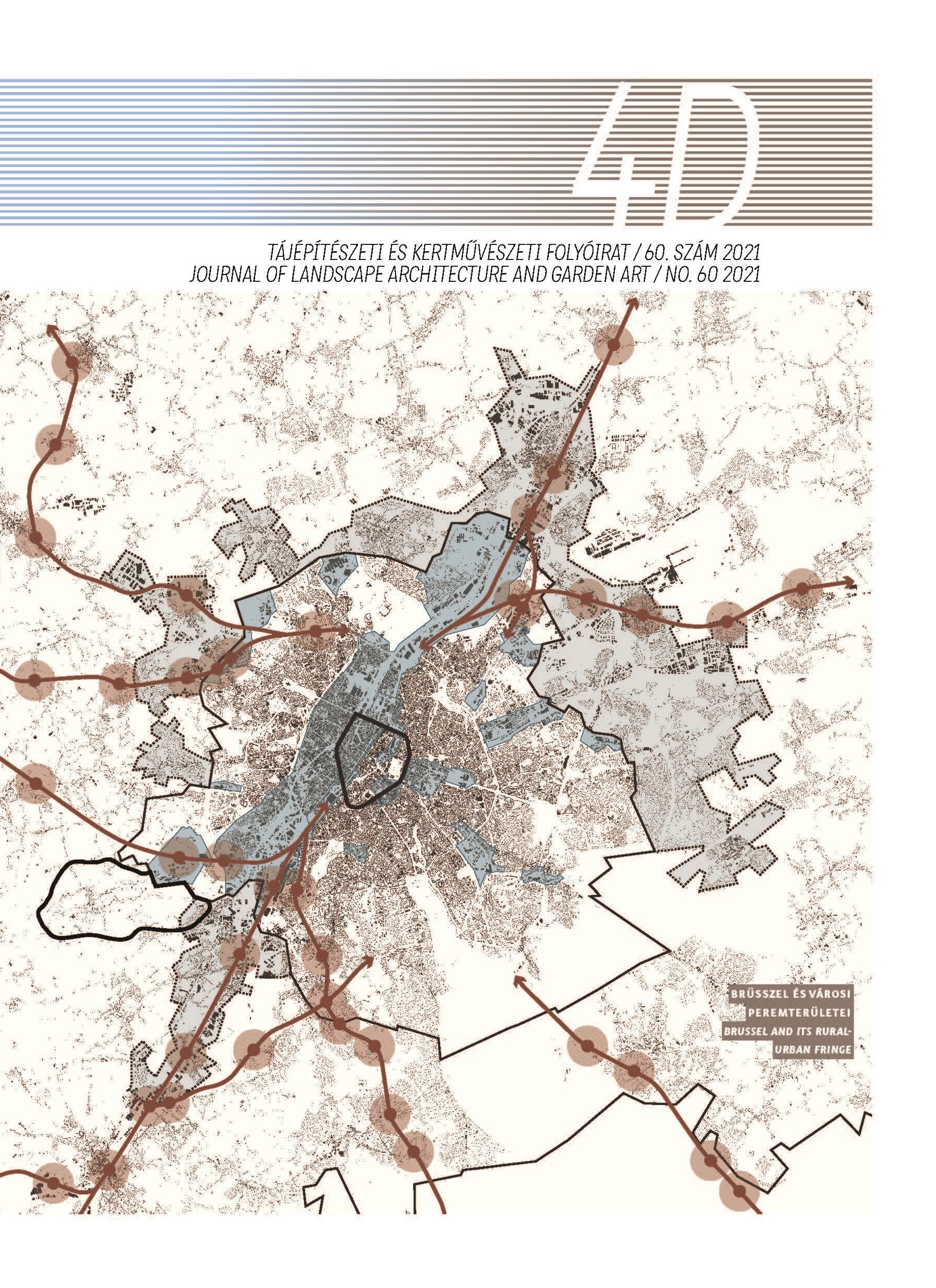Faegyedek településképi jelentőségének percepcionális vizsgálata
DOI:
https://doi.org/10.36249/60.5Kulcsszavak:
cultural ecosystem services, urban trees, cityscape, perceptional surveyAbsztrakt
A városi fák a település- és utcakép, valamint a helyi karakter meghatározó elemei, az általuk nyújtott ökoszisztéma-szolgáltatások pedig népszerű kutatási témát jelentenek. Ugyanakkor még ma, évekkel a magyar településkép-védelmi eszközrendszer új elemekkel történő kibővítése után is csak viszonylag kevés ismerettel rendelkezünk az egyes fák, mint településképi értékek meghatározó szerepének hátteréről. Kutatásunkban egy Dél-Budán kijelölt mintaterületen percepcionális módszerrel vizsgáltuk az egyes faegyedek településképet meghatározó szerepét. 74 résztvevőt kértünk meg arra, hogy járják be a 15 hektár kiterjedésű vizsgálati területet és nevezzék meg azt a legfeljebb 10 faegyedet, amelyek szerintük a településképben leginkább meghatározó szerepet tölt be. Eredményeink azt mutatják, hogy bár igen nagyszámú fát választott ki legalább egy résztvevő, egyes egyedek szignifikánsan magas számú szavazatot kaptak – közülük néhány fát a résztvevők több, mint 20%-a választott ki. Eredményeink alapján elmondható továbbá, hogy a fákkal kapcsolatos szakmai háttérrel rendelkező kitöltők és a laikusok hasonló véleményt fogalmaztak meg, ugyanakkor kisebb eltérések is megfigyelhetők. Kutatásunk alátámasztja, hogy – a hagyományos, fenntartói szemléletű faérték-számítási módszerektől eltérően – a faegyedek faja, illetve egészségügyi állapota kevésbé jelentősen befolyásolja a faegyedek településképi értékét. Más tényezők, mint az elhelyezkedés vagy a környezettel kontrasztban álló szín vagy forma, jóval meghatározóbbak.
Hivatkozások
MSZ 12042:2019 Fák védelme építési területeken. Budapest: Magyar Szabványügyi testület. [online] In: Magyar Szabványügyi Testület honlapja. URL: https://ugyintezes.mszt.hu/Publications/Details/172822 [2021. 07. 30.]
MSZ 12172:2019 Díszfák és díszcserjék ültetése települések közterületein. Budapest: Magyar Szabványügyi Testület. online] In: Magyar Szabványügyi Testület honlapja. URL: https://ugyintezes.mszt.hu/Publications/Details/172821 [2021. 07. 30.]
Szakács B. (ed) (2018): Zöldinfrastruktúra füzetek 4: Városi fák és közművek kapcsolata. Tervezési útmutató. Budapest: Főváros Főpolgármesteri Hivatal. URL: https://docplayer.hu/ [2021. 07. 30]
Szakács B. (ed) (2021): Zöldinfrastruktúra füzetek 6: Fahelyek és zöldsávok védelme a városi utak mentén. Budapest: Budapest Főváros Főpolgármesteri Hivatal.
Bp FATÁR adatbázis és applikáció. Budapest: Főkert ZRt. [online] In: Főkert honlapja. URL: https://www.fokert.hu/bpfatar/ [2021. 07. 30.]
Faértékszámítás. [online] Érd: Magyar Faápolók Egyesülete. In: Magyar Faápolók Egyesület honlapja. URL: https://faapolok.hu/faertekszamitas/ [2021. 07. 30.]
Szaller V. (ed) (2013): Útmutató a fák nyilvántartásához és egyedi értékük kiszámításához. Magyar Faápolók Egyesülete: Budapest. URL: https://faapolok.hu/
Gerstenberg, T. – Hifmann, M. (2016): Perception and preference of trees: A psychological contribution to tree species selection in urban areas. Urban Forestry & Urban Greening, 15, 103-111. DOI: https://doi.org/10.1016/j.ufug.2015.12.004
López Arce, – Miguel Ángel (1975): El cálculo de indemnizaciones derivadas de la pérdida de árboles ornamentales. ICONA: Madrid.
Jószainé Párkányi I. (2005) A közcélú zöldfelületi vagyon értékelésének metodikai lehetőségei és használata a település gazdálkodásban. Tájépítészet, 6(2), 16-22.
Asociación Española de Parques y Jardines Públicos (2007): Método para valoración de árboles y arbustos ornamentales: Norma Granada: revisión 1999. Asociación Española de Parques y Jardines Públicos: Madrid, Spain.
LTOA (London Tree Officers Association) (2012): Capital Asset value for Amenity Trees (CAVAT). URL: https://www.ltoa.org.uk/documents-1/ [2021. 07. 30.]
Hegedüs A. – Gaál M. – Bérces R. (2011): Tree appraisal methods and their application - First results in one of Budapest’s districts. Applied Ecology and Environmental Research, 9(4), 411-423. URL: https://www.aloki.hu/pdf/0904_411423.pdf
Lechner Tudásközpont Területi, Építészeti és Informatikai Kft. (2017): Útmutató Településképi Arculati Kézikönyvek Készítéséhez. Budapest.
Constanza, R. – D’Arge, R. – De Groot, R. et al. (1997): The value of the world's ecosystem services and natural capital. Nature, 387, 253–260. URL: https://www.nature.com/
Millennium Ecosystem Assessment (MEA) (2005): Ecosystems and Human Well-being: A Framework for Assessment. Island Press: Washington, DC. URL: https://www.millenniumassessment.org/documents/document.356.aspx.pdf
Cheng, X. – Van Damme, S. – Li, L. – Uyttenhove, P. (2019): Evaluation of cultural ecosystem services: A review of methods. Ecosystem Services, 37, Article 100925. DOI:https://doi.org/10.1016/j.ecoser.2019.100925
Wallace, K.J. (2007): Classification of ecosystem services: Problems and solutions. Biological Conservation, 139(3–4), 235–246. DOI: http://doi.org/10.1016/j.biocon.2007.07.015
Abualhagag, A. – Valánszki I. (2020): Mapping indicators of Cultural Ecosystem Services: Review and relevance to urban context. Journal of Landscape Ecology, 13(1), 4-24. DOI: https://doi.org/10.2478/jlecol-2020-0001
Hernández-Morcillo, M. – Plieninger, T. – Bieling, C. (2013): An empirical review of cultural ecosystem service indicators. Ecological Indicators, 29, 434–444. DOI: https://doi.org/10.1016/j.ecolind.2013.01.013
Blicharska, M. – Smithers, R.J. – Hedblom, M., et al. (2017): Shades of grey challenge practical application of the cultural ecosystem services concept. Ecosystem Services, 23, 55-70. DOI: http://dx.doi.org/10.1016/j.ecoser.2016.11.014
Tengberg, A. – Fredholm, S. – Eliasson, I. (2012): Cultural ecosystem services provided by landscapes: Assessment of heritage values and identity. Ecosystem Services, 2, 14–26. DOI: http://dx.doi.org/10.1016/j.ecoser.2012.07.006
Council of Europe (2000): European Landscape Convention. ETS No. 176. Council of Europe Publishing Division: Strasbourg
Brown, G. – Fagerholm, N. (2015): Empirical PPGIS/PGIS mapping of ecosystem services: a review and evaluation. Ecosystem Services, 13, 119-133. DOI: https://doi.org/10.1016/j.ecoser.2014.10.007
Valánszki I. – Filepné Kovács K. (2018): PPGIS módszer alkalmazhatóságának vizsgálata különböző táji értékek azonosítására. Tájökológiai Lapok, 16(1), 13-22. URL: http://real.mtak.hu/82532/1/02_Valanszki_Filepne_u.pdf
Plieninger, T. – Dijks, S. – Oteros-Rozas, E.– Bieling, C. (2013): Assessing, mapping, and quantifying cultural ecosystem services at community level. Land Use Policy, 33, 118–129. DOI: http://doi.org/10.1016/j.landusepol.2012.12.013
Bubalo, M. – Van Zanten, B.T. – Verburg, P.H. (2019): Crowdsourcing geo-information on landscape perceptions and preferences: A review. Landscape and Urban Planning, 184,101-111. DOI: https://doi.org/10.1016/j.landurbplan.2019.01.001
Letöltések
Megjelent
Folyóirat szám
Rovat
License
Copyright (c) 2021 László Nádasy, Valánszki István

This work is licensed under a Creative Commons Attribution-NonCommercial-NoDerivatives 4.0 International License.
A folyóirat Open Access (Gold). Cikkeire a Creative Commons 4.0 standard licenc alábbi típusa vonatkozik: CC-BY-NC-ND-4.0. Ennek értelmében a mű szabadon másolható, terjeszthető, bemutatható és előadható, azonban nem használható fel kereskedelmi célokra (NC), továbbá nem módosítható és nem készíthető belőle átdolgozás, származékos mű (ND). A licenc alapján a szerző vagy a jogosult által meghatározott módon fel kell tüntetni a szerző nevét és a szerzői mű címét (BY).









 intézetigazgató: Dr. Fekete Albert
intézetigazgató: Dr. Fekete Albert

